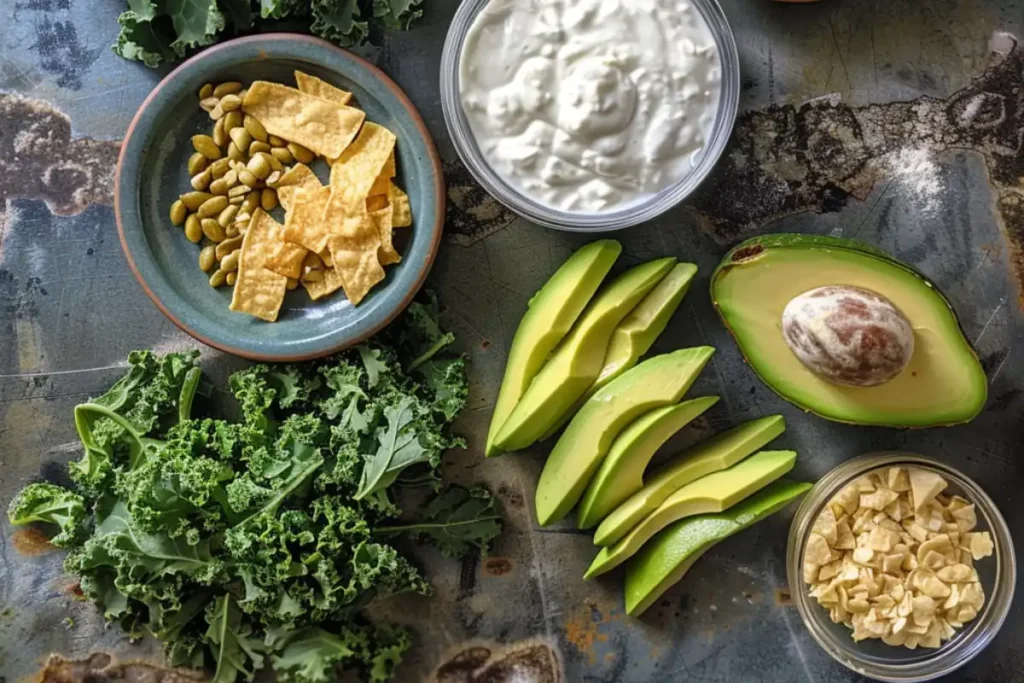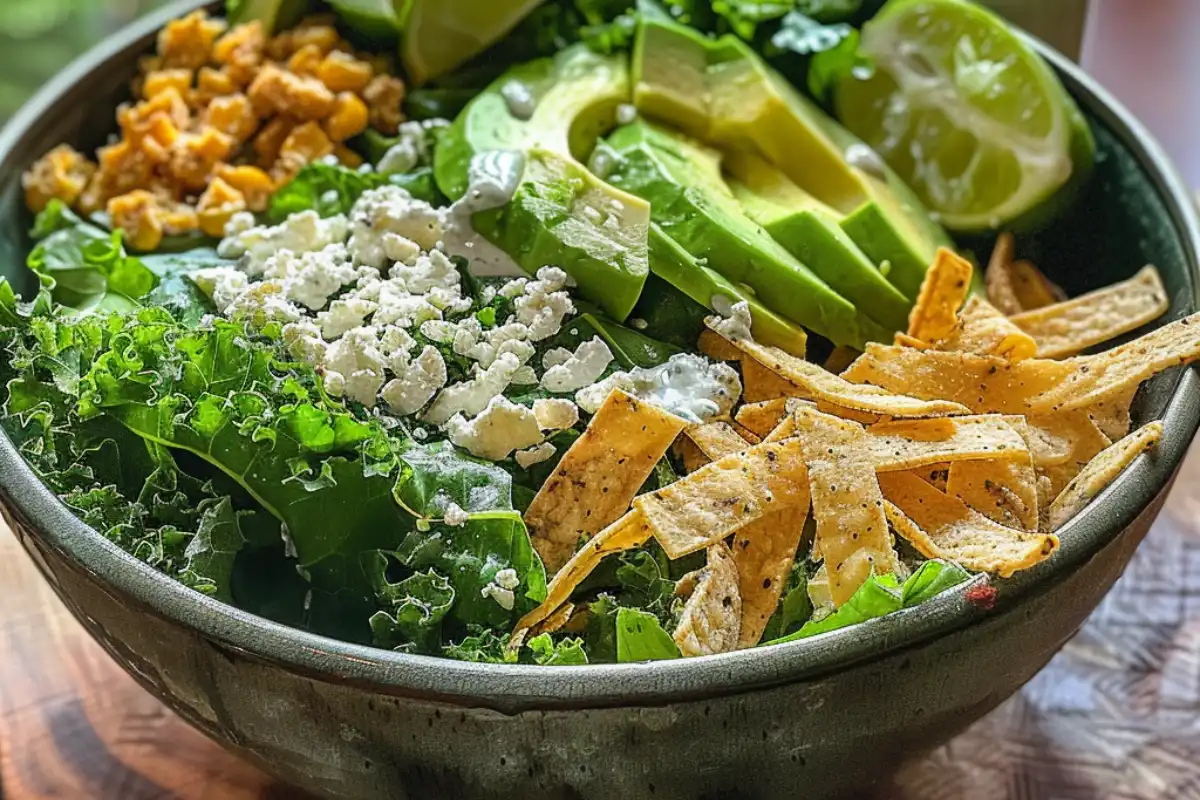The Mexican Caesar Salad is an exciting and bold reimagination of the classic Caesar salad. By combining the rich flavors of traditional Caesar ingredients with the zest and vibrancy of Mexican cuisine, this salad creates a perfect harmony of creamy textures, crunchy toppings, and fresh greens. Think of it as the classic Caesar salad you know and love, but with an infusion of avocado, tortilla strips, cotija cheese, pepitas, and more!
This dish is ideal for a light lunch or dinner, and its flavors are sure to impress at any gathering. The addition of ingredients like Greek yogurt in the dressing also gives this dish a healthier edge, making it perfect for those who want to enjoy a salad that is both indulgent and nutritious.
Table of Contents
The Origins of Caesar Salad
Before delving into the specifics of Mexican Caesar Salad, it’s important to understand where the original Caesar salad came from. Surprisingly, the origins of Caesar salad can be traced to Mexico. Caesar Cardini, an Italian-American restaurateur, is credited with creating this iconic dish in his Tijuana restaurant during the 1920s.
Legend has it that on a particularly busy day, Caesar Cardini had to improvise with the ingredients he had on hand. The result? The now-famous combination of Romaine lettuce, Parmesan cheese, croutons, and a creamy dressing made from garlic, lemon juice, raw egg yolks, and olive oil. This impromptu dish became a hit and quickly spread throughout North America.
Today, Caesar salad remains a staple on restaurant menus, with countless variations—including the delicious Mexican Caesar Salad. This fusion takes the base ingredients of a traditional Caesar salad and gives them a Mexican twist, incorporating flavors like avocado, pepitas, and cotija cheese for added richness and crunch.
Step-by-Step Recipe for Mexican Caesar Salad

Let’s break down how to make your own Mexican Caesar Salad at home. With these simple steps, you’ll have a delicious salad ready in no time.
Ingredients:
- 5–6 cups chopped kale (stems removed)
- 4 cups chopped Romaine lettuce
- 1 avocado, peeled and sliced
- 1 cup fried or baked tortilla strips
- 1/2 cup toasted pepitas
- 1/3 cup crumbled cotija cheese
- 1 batch of Greek yogurt Caesar dressing
Instructions:
1. Prepare the Greens
Start by chopping the kale and Romaine lettuce into bite-sized pieces. If you’re using kale, make sure to massage it with a bit of olive oil to soften the leaves. This step helps break down the tough fibers and makes the kale more tender.
2. Make the Dressing
In a small bowl, whisk together Greek yogurt, lime juice, garlic, Dijon mustard, anchovies (optional), and olive oil. For a smoother texture, you can also blend the ingredients using a food processor. Adjust the seasoning with salt and pepper to taste.
3. Toast the Pepitas
Heat a small skillet over medium heat and add the pepitas. Stir frequently until the seeds puff up and turn golden brown, which should take just a few minutes. Make sure to keep an eye on them to avoid burning.
4. Fry or Bake the Tortilla Strips
Slice corn tortillas into strips and either fry them in oil until crispy or bake them in the oven at 375°F until golden and crisp. This step provides a crunchy element that replaces the croutons traditionally found in Caesar salad.
5. Assemble the Salad
In a large salad bowl, combine the chopped greens with sliced avocado, toasted pepitas, tortilla strips, and crumbled cotija cheese. Drizzle the Greek yogurt Caesar dressing over the salad and toss gently to combine all the ingredients.
6. Serve
Serve immediately to maintain the crisp texture of the tortilla strips. This salad makes an excellent side dish or a light main course. For a heartier meal, you can add grilled chicken, shrimp, or steak.
For a different kind of salad experience, you might also want to try Street Corn Pasta Salad, which fuses Mexican street food flavors with a pasta base.
Health Benefits of Mexican Caesar Salad
The Mexican Caesar Salad offers a variety of health benefits thanks to its fresh, nutrient-dense ingredients. Here’s a closer look at why this salad is as nutritious as it is delicious:
- Kale & Romaine: Low in calories, rich in vitamins A, C, K, and antioxidants.
- Avocado: Packed with heart-healthy fats, fiber, and potassium.
- Pepitas: A great source of omega-3s, protein, and fiber.
- Greek Yogurt: Adds protein, probiotics, and a creamy texture with fewer calories.
For a fun variation on classic flavors, check out Crab Brûlée Recipe, a unique seafood dish that also blends traditional elements with unexpected twists.
Variations of Mexican Caesar Salad

The beauty of Mexican Caesar Salad lies in its versatility. You can easily customize the salad to suit your preferences. Here are some variations you can try:
1. Add Protein
Adding protein to your salad can turn it into a more filling main course. Here are a few protein options that pair well with the flavors in the salad:
- Grilled chicken: Adds lean protein and complements the creamy dressing.
- Shrimp: Grilled or sautéed shrimp work wonderfully with the tangy lime dressing.
- Steak: For a heartier meal, add slices of grilled steak.
2. Spicy Twist
- If you enjoy a little heat, you can add spice to your Mexican Caesar Salad. Incorporate finely chopped jalapeños or a dash of hot sauce into the dressing for a spicy kick. Alternatively, sprinkle some chili powder or cayenne on top for added flavor.
3. Vegetarian and Vegan Options
- To make this salad vegetarian, simply omit the anchovies from the dressing. For a vegan version, skip the cheese and use a plant-based yogurt in the dressing. You can also add nutritional yeast for a cheesy flavor without using dairy.
Serving Suggestions
Mexican Caesar Salad is incredibly versatile and pairs well with a wide variety of dishes. Here are some serving suggestions:
- Serve as a main course with added protein like grilled chicken or steak.
- Pair with other Mexican dishes like tacos, enchiladas, or quesadillas for a complete meal.
- Enjoy as a side salad alongside Mexican street corn or Elote Dip for a true Mexican feast.
Check out this Elote Dip Recipe for another Mexican-inspired dish to complement your meal.
Mexican Caesar Salad is a flavorful, zesty, and healthy twist on the classic Caesar salad. By incorporating avocado, tortilla strips, and Greek yogurt Caesar dressing, you can elevate this dish with the vibrant flavors of Mexico while keeping it light and nutritious.
Whether you’re looking for a satisfying side salad or a complete meal, this recipe delivers on all fronts. The perfect balance of creaminess, crunch, and tangy flavors ensures it will be a hit with family and friends alike.
So gather your ingredients, and let’s enjoy this fresh, flavorful twist on a classic dish!
Frequently Asked Questions (FAQs)
1. What is Mexican Caesar Salad made of?
- Mexican Caesar Salad combines traditional Caesar salad elements like Romaine lettuce, Caesar dressing, and croutons with Mexican-inspired ingredients such as avocado, tortilla strips, pepitas, and cotija cheese.
2. Can you make Mexican Caesar Salad vegan?
- Yes! To make a vegan version, skip the cheese and use a plant-based yogurt for the dressing. Replace the anchovies with capers or miso to mimic the umami flavor.
3. Is Mexican Caesar Salad healthy?
- Yes! Mexican Caesar Salad is a nutritious option, especially when made with Greek yogurt dressing and nutrient-dense ingredients like kale, avocado, and pepitas. It offers a great balance of protein, fiber, and healthy fats.
4. Can you make Mexican Caesar Salad ahead of time?
- You can prepare the salad ingredients in advance, but it’s best to store the dressing and tortilla strips separately to prevent sogginess. Combine just before serving for the freshest taste.
Mexican Caesar Salad
This Mexican Caesar Salad is a bold and zesty twist on the classic! Featuring crisp romaine, a creamy cilantro-lime dressing, crunchy tortilla strips, and cotija cheese, this salad is packed with flavor and perfect as a side or main dish! 🥗🌿🌶️
- Prep Time: 10 minutes
- Total Time: 10 minutes
- Category: Lunch
- Method: No-Cook
- Cuisine: Mexican, Fusion
Ingredients
For the Salad:
- 5–6 cups chopped kale (stems removed)
- 4 cups chopped Romaine lettuce
- 1 avocado, peeled and sliced
- 1 cup fried or baked tortilla strips
- ½ cup toasted pepitas (pumpkin seeds)
- ⅓ cup crumbled cotija cheese
For the Greek Yogurt Caesar Dressing:
- ½ cup Greek yogurt
- ¼ cup freshly grated Parmesan cheese
- 2 tbsp olive oil
- 2 tbsp fresh lemon juice
- 1 tsp Dijon mustard
- 1 tsp Worcestershire sauce
- 1 clove garlic, minced
- ½ tsp salt
- ¼ tsp black pepper
- ¼ tsp smoked paprika (optional)
- 2–3 tbsp water (to thin, if needed)
Instructions
-
Make the Dressing:
- In a small bowl or blender, whisk together Greek yogurt, Parmesan, olive oil, lemon juice, Dijon mustard, Worcestershire sauce, garlic, salt, pepper, and smoked paprika until smooth.
- Add water as needed to thin the dressing to your desired consistency.
-
Prepare the Salad:
- In a large bowl, massage kale for about 1 minute to soften.
- Add chopped Romaine, avocado slices, tortilla strips, toasted pepitas, and cotija cheese.
-
Dress & Serve:
- Drizzle the salad with Greek yogurt Caesar dressing and toss gently to combine.
- Serve immediately and enjoy!
Notes
- For added protein, top with grilled chicken, shrimp, or steak.
- For a spicier dressing, add diced jalapeño or more chili powder.
- For a dairy-free version, use a dairy-free yogurt alternative.



4 thoughts on “Mexican Caesar Salad”